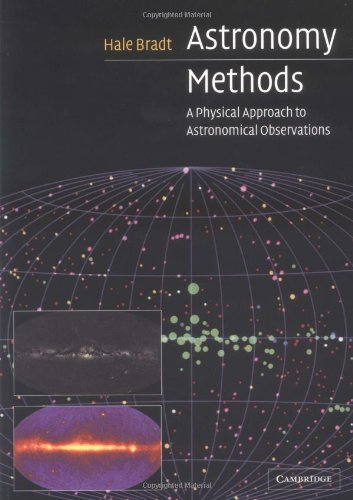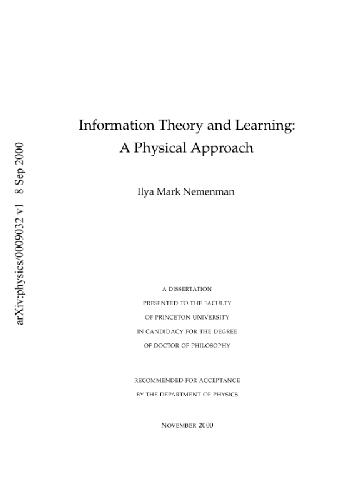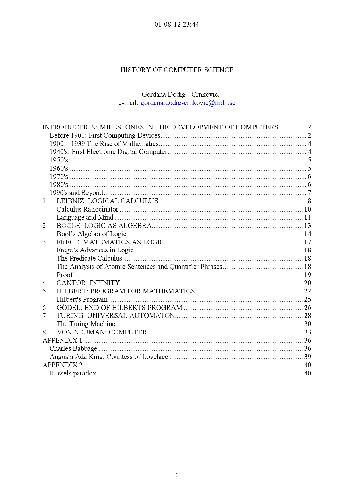Hale Bradt0521535514, 9780521535519
Table of contents :
Cover……Page 1
Half-title……Page 3
Title……Page 5
Copyright……Page 6
Dedication……Page 7
Contents……Page 9
Figures……Page 16
Tables……Page 20
Preface……Page 21
Acknowledgments……Page 24
First astronomers……Page 27
Renaissance……Page 31
Telescopes, photography, electronics, and computers……Page 33
Non-optical astronomy……Page 34
Stars and nebulae……Page 36
Galaxies and the universe……Page 39
New horizons……Page 45
Problems……Page 47
2.1 Introduction……Page 48
Photons (electromagnetic waves)……Page 49
Neutrino and gravitational-wave astronomy……Page 50
Wavelength and frequency……Page 51
Photon energy……Page 52
Temperature……Page 54
Atmospheric absorption……Page 55
2.3 Electromagnetic frequency bands……Page 58
2.4 Photons and the atmosphere……Page 59
3.1 Introduction……Page 60
Mathematical sphere at “infinity”……Page 61
Celestial coordinate systems……Page 62
Equatorial coordinates……Page 63
Why equatorial coordinates?……Page 65
Galactic coordinates……Page 66
Ecliptic coordinate system……Page 69
Reference frames……Page 70
3.3 Solid angle on the celestial sphere……Page 71
Palomar, SRC, and ESO sky surveys……Page 74
Printed charts……Page 76
Catalogs of celestial objects……Page 77
Names of astronomical objects……Page 78
Stars……Page 79
Modern names (“telephone numbers”)……Page 80
3.2 Coordinates on a celestial sphere……Page 81
3.4 Surveys, charts and catalogs……Page 82
4 Gravity, celestial motions, and time……Page 83
4.2 Gravity – Newton to Einstein……Page 84
Horizon coordinate system……Page 86
Sun and dark-sky observations……Page 88
Parallax of star positions……Page 89
Stellar aberration……Page 91
Torque due to a ring of mass……Page 92
Calendar……Page 95
Proper motion……Page 96
Motion on celestial sphere……Page 97
Eclipses of the sun and moon……Page 98
“Orbits” of the moon and sun……Page 99
Total and partial solar eclipses……Page 100
The 18-year saros cycle……Page 101
Corona in x rays and visible light……Page 103
Planets……Page 105
Time according to the stars and sun……Page 106
Mean solar time……Page 107
Greenwich mean sidereal time (GMST) at 0 h UT……Page 109
Atomic time (TAI)……Page 110
Universal coordinated time (UTC) and leap seconds……Page 111
Terrestrial time (TT)……Page 112
Barycentric times……Page 114
Epochs for coordinate systems……Page 115
4.2 Gravity……Page 117
4.3 Apparent motions of stars……Page 119
4.4 Lunar and planet motions – eclipses……Page 120
4.5 Measures of time……Page 122
5.1 Introduction……Page 124
5.2 Information content of radiation……Page 125
5.3 Image formation……Page 126
Focal length and plate scale……Page 127
Aperture and deposited energy……Page 128
Telescope configurations……Page 130
Tubular and modulation collimators……Page 132
Multiple pinhole collimator……Page 133
Some real telescopes……Page 136
Meaning of a “beam”……Page 138
Point spread function……Page 140
Fraunhofer diffraction……Page 141
Radio resolution……Page 144
Isophase patches and speckles……Page 145
Speckle interferometry……Page 150
Sensing the wavefront shape……Page 151
Complete system……Page 152
5.5 Resolution enhancement……Page 155
6.1 Introduction……Page 156
Photomultiplier and photometry……Page 157
Proportional counter……Page 159
Charge-coupled device……Page 163
Structure of a CCD……Page 164
Readout of the image……Page 166
Utility in optical astronomy……Page 168
Adaptive imaging……Page 169
Utility in x-ray astronomy……Page 170
Plastic scintillator anticoincidence……Page 171
Spark chamber detection of electron–positron pair……Page 173
Energies and arrival directions……Page 174
BATSE experiment……Page 175
6.5 Statistics of measurements……Page 177
Statistical fluctuations – “noise”……Page 178
Poisson distribution……Page 179
Normal distribution……Page 181
Variance and standard deviation……Page 183
Measurement significance……Page 185
Statistical traps……Page 186
Propagation of errors……Page 187
Background subtraction……Page 188
Low and high background limits……Page 189
Bright and faint source observations……Page 190
Comparison to theory……Page 191
Finding parameters and checking hypotheses……Page 192
Least squares fit……Page 193
Chi square test……Page 194
6.3 Position-sensitive detectors……Page 198
6.5 Statistics of measurements……Page 199
7 Multiple telescope interferometry……Page 201
7.1 Introduction……Page 202
Principle of interferometry……Page 203
Transmission of radiation……Page 205
Reception……Page 207
Position of source……Page 208
North-Pole observation……Page 209
All-sky fringe pattern……Page 211
Summed waves……Page 214
Multiplied waves……Page 217
Signal processing……Page 219
Spatial frequencies……Page 220
Projected baseline……Page 222
Bins on the sky……Page 223
Cross-correlation……Page 225
Equal weighting of time intervals……Page 226
Principle of aperture synthesis……Page 227
Arbitrary sky brightness distribution……Page 229
Phase of visibility function……Page 231
Sky brightness……Page 232
Cleaning algorithms……Page 233
Multiple baselines……Page 234
Radio arrays……Page 235
Optical and x-ray interferometry……Page 238
7.2 Two-telescope interference……Page 239
7.3 Mapping the sky……Page 241
7.4 Arrays of telescopes……Page 243
8 Point-like and extended sources……Page 244
8.1 Introduction……Page 245
Spectral flux density……Page 246
Luminosity……Page 248
8.3 Astronomical magnitudes……Page 250
Magnitudes and fluxes……Page 251
Spectral color bands……Page 252
Conversion from magnitudes to SI units……Page 254
Color indices……Page 256
Absolute magnitudes – luminosity……Page 257
Bolometric magnitude……Page 258
Absolute bolometric magnitude and luminosity……Page 259
Specific intensity……Page 260
Concept of specific intensity……Page 261
Power received by antenna……Page 263
Average specific intensity……Page 264
Relation to specific intensity……Page 265
Specific intensity of pulsars……Page 266
Power emitted from a surface……Page 267
Equality of emitted and received intensity (B = I)……Page 268
Energy flow – names, symbols, and units……Page 271
Volume emissivity……Page 272
Relation to specific intensity……Page 273
Line-of-sight emissivity (power column density)……Page 275
8.3 Astronomical magnitudes……Page 276
8.4 Resolved “diffuse” sources……Page 277
9 Properties and distances of celestial objects……Page 279
9.2 Luminosities……Page 280
Earth and sun……Page 282
Moon……Page 283
Spiral galaxies and the Galaxy……Page 284
Clusters of galaxies and the virial theorem……Page 285
Thermal and non-thermal radiation……Page 286
Color temperature……Page 287
Excitation temperature……Page 288
Ionization temperature……Page 289
Saha equation……Page 290
Distance ladder……Page 291
Moon, earth, and sun……Page 293
Trigonometric parallax……Page 295
Convergence……Page 296
Distance to a cluster star……Page 298
Secular parallax……Page 299
Statistical parallax……Page 301
Standard candles……Page 302
Spectroscopic classification……Page 303
Galactic center and Crab nebula distances……Page 304
Cepheid and RR Lyrae variables……Page 305
Expanding universe……Page 308
Value of Hubble constant……Page 309
Redshift……Page 310
Extragalactic “standard candles”……Page 311
Luminosity functions……Page 312
Supernovae……Page 313
Surface brightness fluctuations……Page 314
Ultimate goals……Page 318
9.1 Introduction……Page 320
9.3 Masses……Page 321
9.5 Distances and sizes……Page 322
10.1 Introduction……Page 324
Rayleigh scattering……Page 326
Thomson scattering……Page 327
Compton scattering……Page 328
Photon absorption in the CMB……Page 329
Emission nebulae……Page 330
Grains in the interstellar medium……Page 332
Extinction coefficient……Page 334
Extragalactic sources……Page 335
Color excess (reddening)……Page 336
Frequency dependence……Page 337
Dust–hydrogen association……Page 338
Cross section as a target……Page 340
Exponential absorption……Page 342
Mass units and opacity……Page 343
Optical depth……Page 344
Cross section and extinction coefficient……Page 345
Photoelectric effect……Page 347
Mass fractions……Page 349
Effective cross section……Page 350
Survival distances……Page 352
Astronomy through gases……Page 354
10.3 Extinction of starlight……Page 356
10.5 Photoelectric absorption in the interstellar medium……Page 357
11.1 Introduction……Page 359
Energy and number spectra……Page 360
Spectral reference band……Page 362
Frequency and wavelength……Page 363
Spectral bin widths……Page 364
Free–bound, bound–free and free–free transitions……Page 365
Radiation from a hot plasma……Page 366
Plasma parameters determined……Page 367
Shocks in supernova remnants, stellar coronae, H II regions……Page 369
Synchrotron radiation……Page 370
Spectrum……Page 374
Radio spectra and antenna temperature……Page 375
Cosmic microwave background……Page 376
Stars……Page 377
11.4 Spectral lines……Page 380
Origin of spectral lines……Page 381
Stars and nebulae……Page 383
Permitted and forbidden lines……Page 384
Equivalent width……Page 385
Damping and thermal profiles……Page 387
Saturation and the curve of growth……Page 390
Radiative transfer equation (RTE)……Page 391
Intensity differentials……Page 392
Intensity variation with optical depth……Page 393
Local thermodynamic equilibrium……Page 394
Solution of the RTE……Page 395
Limiting cases……Page 397
11.3 Continuum spectra……Page 401
11.4 Spectral lines……Page 402
11.5 Formation of spectral lines (radiative transfer)……Page 403
12 Astronomy beyond photons……Page 404
Neutrinos from the sun……Page 405
Neutrino–chlorine conversions……Page 408
Argon decay……Page 409
Solar neutrino problem……Page 410
Super-Kamiokande……Page 411
Cerenkov radiation……Page 412
Neutrino oscillations and more……Page 413
12.3 Cosmic ray observatories……Page 414
Nuclear component……Page 415
Muon component……Page 416
Extensive air showers……Page 418
Cerenkov radiation and fluorescence……Page 420
Detection of EAS……Page 421
Fly’s Eye……Page 422
Auger project……Page 423
Gamma-ray primaries – TeV and EeV astronomy……Page 424
Orbiting neutron stars……Page 425
Energy loss rate……Page 426
Distortion of space……Page 428
Quadrupole radiation……Page 429
Variable quadrupole moment……Page 431
Detection in Virgo cluster……Page 433
Resonant bars……Page 434
Laser interferometers……Page 435
Multiple antennas……Page 436
12.2 Neutrino observatories……Page 437
12.3 Cosmic ray observatories……Page 438
12.4 Gravitational-wave observatories……Page 439
Credits and further reading……Page 441
General astrophysics texts for science majors……Page 443
Appendix Units, symbols, and values……Page 444
Index……Page 448







Reviews
There are no reviews yet.